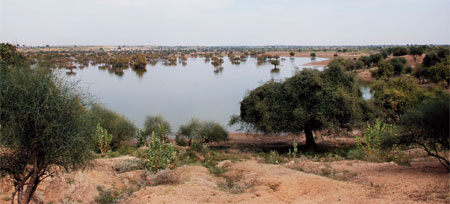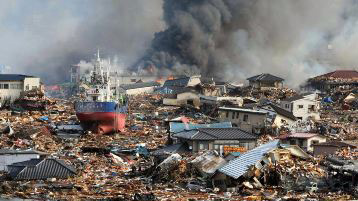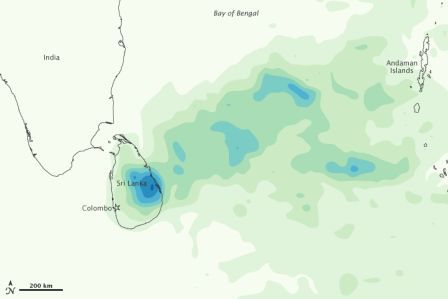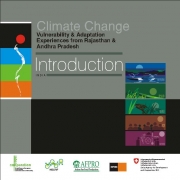/topics/droughts-and-floods
Droughts and Floods
Lingering floods in Pakistan - Updates from Earth Observatory
Posted on 15 Apr, 2011 09:49 AM
A combination of factors, including La Niña and a strange jet stream pattern, caused devastating floods. The Indus River rapidly rose, and a dam failure in Sindh Province sent part of the river down an alternate channel. The resulting floodwater lake lingered for months, leaving crops, roads, airports, even entire communities underwater.
Farming practices in different water regimes: Action - Newsletter of AFPRO for April 2011
Posted on 14 Apr, 2011 07:22 PMWater turns the tide - A barren district of Rajasthan is seeing development, thanks to rains last year and floods in 2006
Posted on 12 Apr, 2011 11:31 AMArticle and Image Courtesy: Down To Earth
Author:
A barren district of Rajasthan is seeing development, thanks to rains last year and flood in 2006.
 Administration has revived a man-made pond in Nagarda village that was drying up.
Administration has revived a man-made pond in Nagarda village that was drying up.
Photo: Sayantoni Palchoudhuri
Coping with disasters - Himal Southasian Magazine March 2011 special issue
Posted on 24 Mar, 2011 07:42 AM The carnage and devastation in the aftermath of a tsun
The carnage and devastation in the aftermath of a tsun
Canacona flash floods (2009): Reports submitted by the National Institute of Oceanography to the Government of Goa
Posted on 01 Mar, 2011 09:00 PMThe report is based on a study carried out with the help of National Institute of Oceanography (NIO) and attempts to (1) assemble and analyse available information to describe and identify causes behind the flash floods, and (2) suggest measures to be adopted in Goa to minimise damage arising from similar episodes in future.
Towards adopting nanotechnology in irrigation: Micro irrigation systems
Posted on 21 Jan, 2011 07:36 PMIndia is predominantly an agricultural country and even with current orientation towards services, still agriculture contributes ¼th of total GDP of the country, 15 percent of total export and 65 % of total population’s livelihood.
Heavy Rains in Sri Lanka - Update from Earth Observatory
Posted on 20 Jan, 2011 01:48 PMSri Lanka’s government stated that the death toll from flooding had risen to 13, and officials were arranging food drops to hardest-hit areas in the east.

![]()
Managing Natural Resources -A report by IDSAsr
Posted on 18 Jan, 2011 04:24 PMThe scarcity value of natural resources has risen due to rising pressure of human population and demands made by modern economics progress. As such managing these resources has become very important.
Booklets on water quality, river pollution and rainwater harvesting by Janhit Foundation
Posted on 18 Jan, 2011 04:16 PMThe three booklets discuss the issues of water quality, river pollution, and rainwater harvesting, in detail.
Climate change: Vulnerability and adaptation experiences from Rajasthan and Andhra Pradesh – A report by SDC
Posted on 05 Jan, 2011 06:44 PM This document discusses the process oriented programme of Swiss Agency for Development and Cooperation (SDC) on Vulnerability Assessment (V&A) and Enhancing Adaptive Capacity to Climate Change initiated in the semi-arid regions of India. The aims of this programme include strengthening the resilience of local communities to conditions of unfavourable weather, like adverse alterations in temperature and precipitation leading to the more frequent occurrence of drought and to use the experiences for policy development for climate change adaptation measures at various levels.
This document discusses the process oriented programme of Swiss Agency for Development and Cooperation (SDC) on Vulnerability Assessment (V&A) and Enhancing Adaptive Capacity to Climate Change initiated in the semi-arid regions of India. The aims of this programme include strengthening the resilience of local communities to conditions of unfavourable weather, like adverse alterations in temperature and precipitation leading to the more frequent occurrence of drought and to use the experiences for policy development for climate change adaptation measures at various levels.
Over 60 per cent of the cultivated area in India is rainfed & unfavorable and uncertain rainfall patterns will seriously affect the food, drinking water and livelihood security of millions of children, women and men. Since the initiation of this project, the emphasis on proactive research on adaptation mechanisms has increased at the national level.
The present decade may mark the beginning of a new climate era, characterized by extreme and often unpredictable weather conditions and rise in sea levels. The greatest casualty of climate change will be food, water and livelihood security.





